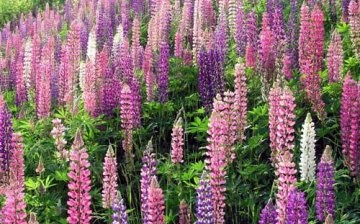Lupine in the photo and its cultivation
Looking at the lupine in the photo, you involuntarily admire its beauty and a huge variety of shades of inflorescences. If you come across such a thing as green manure lupine, it means that this plant is one of those that improve the structure of the soil and provide it with additional nutrients.
If you choose perennial lupine, then you will see the first flowers only the next year after planting the seeds. But in return, you will get a bright ornamental plant that will bloom on your site from year to year, and not just for one summer season.
Growing lupine
Lupine, growing from seeds of which is not too difficult, reaches a height of about 1 meter. The plant blooms profusely from June to September. It is best when planted in a lighted area, as the duration of flowering is usually reduced in the shade. Although lupines without flowering inflorescences also look simply excellent in appearance.
By the way, multifoliate lupine grows better on acidic soils. Therefore, you will need so-called natural soil acidifiers (for example, sawdust or fresh manure), which are applied directly under the flower. It is better when the seeds are already planted in open ground, and not for seedlings, since the plant may not respond in the best way to transplanting.
The lupine plant, the cultivation of which does not take much time, needs quite abundant watering. Before planting, lupine seeds do not require any preliminary preparation (soaking). The main thing is that the soil is sufficiently nutritious, moist and acidic.




The most persistent and perennial plant. As far back as I can remember, all the mountains in the vicinity of our city are covered with lupines. Beauty is indescribable. In the garden, for some reason, he does not grow so tall and does not bloom so abundantly. Although watering is timely and fertilization in the spring we apply a little.